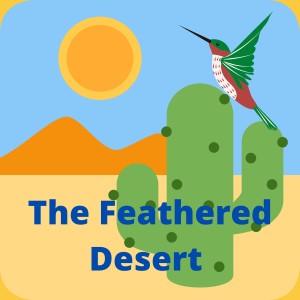
11K
Downloads
144
Episodes
Backyard bird feeding is one of the most enjoyable and rewarding hobbies on earth. Join Cheryl and Kiersten as they talk all about bird feeding in the desert Southwest area of the United States. They talk birds, seed, feeders, and dealing with those pesky unwanted visitors!
Episodes

Monday Dec 18, 2023
Flick This!
Monday Dec 18, 2023
Monday Dec 18, 2023
Summary: Why do birds flick their tails? Join Kiersten and Cheryl as they talk about some of the reasons birds may flick their tails.
For our hearing-impaired listeners, a transcript of this podcast follows the show notes on Podbean.
Show Notes:
“Why Do Birds Flick Their Tails?” Bird Note, June 13, 2023
“Why Do Phoebes Pump Their Tails?” David Sibley, https://sibleyguides.com
“Tail Movements in Birds – Current Evidence and New Concepts,” by Christoph Randler. Ornithological Science 15: 1-14 (2016).
Transcript
Kiersten: Welcome to the Feathered Desert. Have you ever been bird watching and wondered why that bird is flicking its tail? I know I have, so today we’re going to discover why birds flick their tails.
Cheryl: Let’s start off by defining a tail flick. Because, believe it or not, there is an actual definition of a tail flick. Tail flicking refers to the vertical up and down movement of the tail. Tail flashing is the horizontal movement of the tail that often includes spreading of the tail feathers. These tail movements are described with several different names such as tail flick, tail wag, tail flash, tail pump, and tail up display. So, I’m not sure how much our definition REALLY matters.
Researchers believe that most intentional tail movement has to do with communication. That can mean communication to other birds of the same species, or communication to a predator, or to a prey item.
Kiersten: There are several hypotheses about intra species communication. That is communication between the same species of bird.
One hypothesis is communication between possible mates during breeding season. Does tail flicking help find a mate? If you’re the common Moorhen, it just might. The Common Moorhen, also known as the Waterhen and Swamp Chicken, is a member of the Rail family. They are commonly found in wetland areas all around the world. Unlike most species of birds, female moorhens are the ones that fight for the attention of a mate. Tail flicking plays a role in her acquiring a mate. Females will flick their tail to attract a mate’s attention. Researchers found that females with better body condition flicked their tails faster than those with less fat store.
Cheryl: Some birds may be using their tail flicks to coordinate flock behavior. Mallards, a duck found all over the world, but native to North and South America, increase tail flicking before anf after flight. Scientists documented increased tail movement pre-flight and post-flight in the Mallard. They may be using this to let flock members know when to leave and when to settle in.
White-throated Dippers, a European song bird always found near water, also increases its tail movement before and after changing locations.
Kiersten: Some birds use their tail flicks to let predators know they,ve been spotted. This is called perception advertisement. A great example of this is the Eastern Phoebe. I’ve always wondered why I see this bird pumping its tail on occasion when it’s perched. I used to think it was for balance because they sit on the edges of branches to scout for insects. Turns out the tail pumping may used to tell a predator, such as a Cooper’s Hawk, “I see you!” Studies have shown the tail pumps increased in the presence of a predator. That doesn’t mean they only pump their tails when predators are present but it definitely increases when a predator is near.
Dusky Moorhens also use this signal. But the really cool thing is that the rate of their tail flicks changed based on the distance of the predator. As the predator increases distance from the Dusky Moorhen, the tail flicking increases. It increases until the predator is at a far enough distance that the moorhen feels it is safe enough to stop flicking and flee.
Cheryl: The last use for tail flicking that we’ll talk about is movement used to flush prey out of a hiding place. Several bird species that eat insects may use their tail flicks to flush prey out into the open where they are easier to catch. The Northern Mockingbird, Painted Redstart, Slate-throated Redstart, American Redstart, Hooded Warbler, and Willie Wagtail all show behavior that are used to flush insects from their hiding spots. According to researchers, Willie Wagtails only move their tails during feeding and rarely during perching. Tail movements also increased in the shade versus bright sun.
There is good experimental evidence from the redstarts as well. The tail feathers of the redstarts are white. In an experiment, researchers discovered that redstarts with artificially darkened tails were significantly less successful in flush foraging.
Kiersten: Research into tail flicking has certainly answered a lot of questions for us, but keep in mind these movements may be used for many different reasons. There are plenty of hypotheses out there about tail flicks that have yet to be proven or disproven. We have a long was to go to understand this bird behavior.

No comments yet. Be the first to say something!